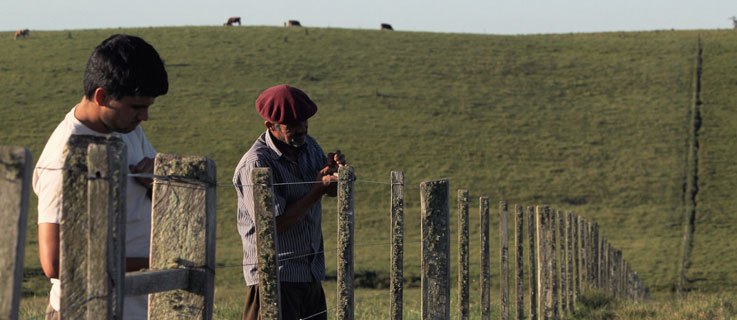The director Davi Pretto takes us on a journey to Brazil’s rural south. Shown in the Forum section, his film is about the powerlessness of the individual in the face of land speculation and the tough reality of rural life – and features the aesthetics of a western.
When major landowners threaten to buy up the small company where he works, Dione decides to dust off his rifle ready for use again. This is the backdrop to Davi Pretto’s second feature film. Using razor-sharp images and a well-chosen cast, the director explores the relationships between landscape and man by confronting his characters with a vast horizon and their own identities. Pretto talks in an interview about his idea for the film and about working with his cast.
How did the idea of looking at rural life come about?
I was inspired to film this region when I travelled with Richard Tavares to the hinterland of Rio Grande do Sul and saw a number of isolated houses dotted around the countryside. This image remained with us whenever our thoughts turned to this remote region that has been all but abandoned, just a tiny handful still managing to stick it out. In 2010, Richard brought me a story and a script entitled El Niño about a teenager from this area who is in conflict with himself and with the people around him. He asked me to direct the project.
What is so special about this landscape that made you want to feature it in the film?
Two things interested me. Firstly, the political aspect of the land conflicts, resistance and violence, and the direct connection with the state of Rio Grande do Sul’s past; and secondly, the sense that this border region is “stuck in a different time”: this non-place with its mystery and ambiguity. The fine line that separates two sides, searching for a path between reality and fantasy.
How is the relationship between the protagonist and the landscape articulated?
For us the landscape was one of the main protagonists, so throughout the process of creating the soundtrack and film footage we had to think about how to depict this. The horizon that swallows people up, the biting wind, the mysteriousness and fear that the night evokes, and the relentless glare of the sun: every detail of this landscape was crucial to the structuring of the narrative. And also the way in which these individual details alter the protagonists.
How did you pick the actors, and how was it to work with them?
The cast was chosen while researching for the film. I wanted to find a genuine family that was similar in composition to the one in the screenplay, which was by no means easy. It took us around six months to find the right family. When they agreed to take part in the film, it was a question of establishing mutual trust, which ultimately resulted in a very special friendship. I was often at their home before shooting began. That was very important, not only because it allowed me to adapt the script, but also because I was able to prepare them for the film work. From time to time I would take a camera with me, do some filming, edit the footage and show it to them. Consequently, they gradually came to trust the way in which they were portrayed on film, which was very important to me. Essentially, it was about making them feel at ease and close to their own reality even while they were telling a different story to that of their own life, and ensuring that they did not lose sight of the narrative and build-up of tension in the film.
